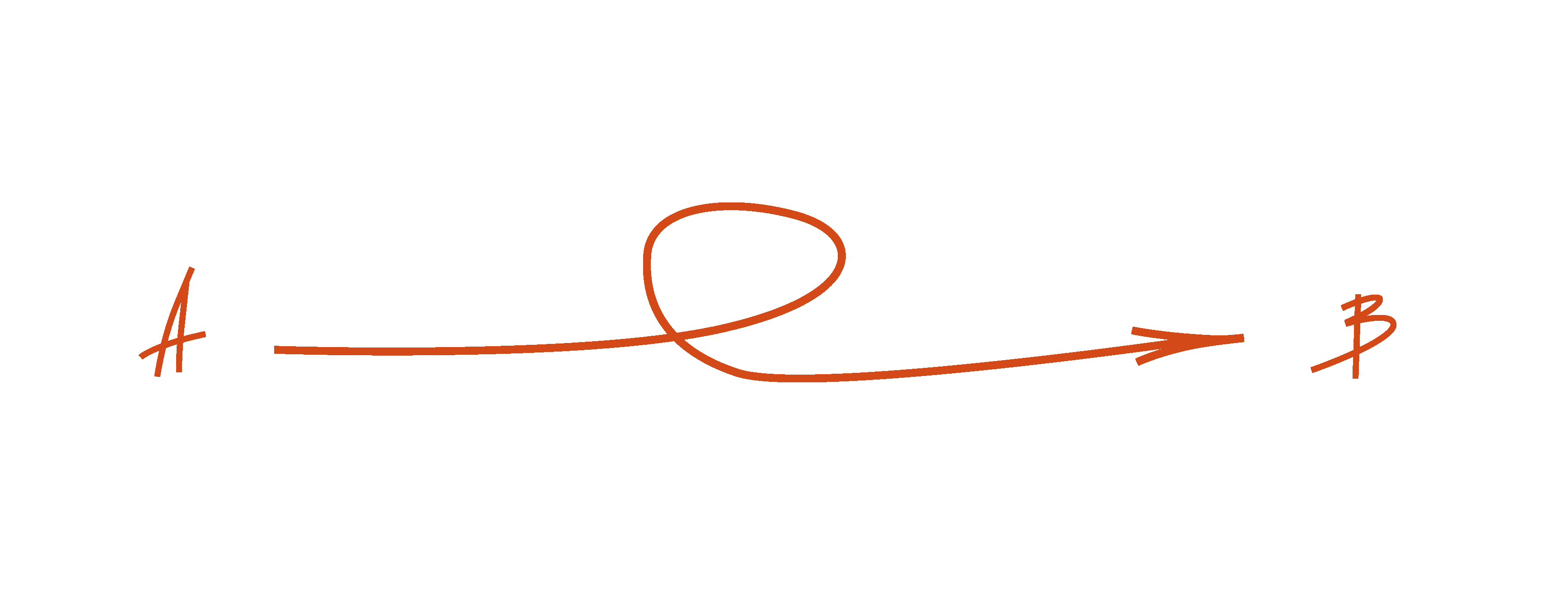My Armed
Mothers
2019 — 2020

MY ARMED MOTHERS combines personal vs. cultural memory and mythology; its influence on human self-identity; unconscious connection of material symbolic objects with folk psyche; connections between art, semiotics and mythology.
The project refers to the mother archetype and monumental history of Post-Soviet countries. It takes four biggest Mother-Motherland monuments of four countries: Russia (90 meters), Georgia (20 meters), Armenia (51 meters) and Ukraine (102 meters), and researches their historical, visual, social, cultural and spiritual parallels; and also their parallels with the contemporary world.
BACKGROUND
In 2018 I was working on an artistic research-based project titled ‘Motherland is Calling’, supported by AFK, Stichting Stokroos and W.E. Jansen Fonds. The project title came from the name of the tallest female sculpture in the world that stays in Volgograd city (formerly Stalingrad) in Russia. The ‘Motherland is calling’ statue is a part of a monumental ensemble commemorating the Battle of Stalingrad that was built in 1967. The ‘Motherland’ is a gigantic woman with a mouth wide open, that calls her ‘children’ to the war, holding her sword high up. The whole territory around the sculpture is a monumental ensemble and a burial place for about 45.000 Soviet soldiers.
The idea to research this topic came from the personal biographical fascination: I was born in Volgograd and visited the monument a number of times. The place has a ‘saint horror’ atmosphere and is perceived as being ‘sacred’ in the contemporary Russian ideology (that takes its roots from the Soviet ideology). The same way it is presented in many related texts, songs, and films. The feeling of this ‘saint horror’ in front of the sculpture [in front of the motherland, in front of the mother, in front of any war-related objects, in front of the ‘war’] was cultivated from the childhood, and is forming a part of Soviet identity. It follows me through all my life, and I see similar feelings in many Russian-speaking people. Within the project I wanted to evaluate this ‘saint horror’ and to give it an artistic shape.
In ‘Motherland is Calling’ project I took the particular ‘Motherland’ sculpture of my childhood, as a study case of the role of female warrior figures in a war cult and propaganda and of the phenomena of ‘motherland‘ sculptures in general. I studied its multi-layered symbolism, its role in shaping the war perception and people’s personal ideologies (mine in particular). Following concepts were relevant to the research: Motherland, Femininity, War, Cults-creating processes and a Monument as a cult object. As a result of this research I created a nonlinear narration in the form of an art-book and a series of prints presented in an installation setting. The project also included a Public Program that articulated the topics of feminine, mother archetype and war cults from sociopolitical, antropological, spiritual and artistic views.
Though it is often referred to Mother Russia as a personification of the Russian nation, during the research I found that many countries have statues of ‘Motherland‘ (or visual idea of it): Indian Bharat Mata, Marianne of French Republic, Spanish "la Madre Patria" and others. Some researchers see these ‘Motherlands’ as symbolic war-goddesses. A female character represents ‘Motherland’, that needs to be protected, or the one that is calling for protection, or just calling to fight (“to die for the Motherland”). Other researchers see these monuments as symbolic metaphors of ‘national identity’ that, at the same time, construct this ‘identity’. As I was interested in the country of my origin, I noticed a repeating type of Mother-Motherland sculptures in former- USSR countries. These Mothers-Motherlands are usually massive sculptures situated on a hill (often a grave), with strong, a bit aggressive, almost goddess-looking faces, with a sword in their hands. I’ve chosen the 4 biggest sculptures I want to focus my research on (that concerns this application): the Mother-Motherlands of Russia, Georgia, Armenia and Ukraine.
These monuments were built at the end of the Soviet Era, and in a way they were symbolic personifications of the soviet ‘Motherland’. The USSR is not there anymore, but these ‘Motherlands’ are still standing and serving as national symbols of the countries. How do these ‘Motherlands’ function in nowadays space? I would like to give these sculptures a voice in the contemporary context, creating a work of art out of their story, and see what results it might bring, what connections and patterns can be traced back in time and space.
Looking at these sculptures from various points: as soviet monumental history, totalitarian architecture, monumental propaganda, artificial community constrictors, and even as war- goddesses of pre-Christian times, I want to combine all these views, to search for their connection, role and the message.
To understand the connection with the cultural psyche of these monumental ‘Motherlands’, I went to the four Post-Soviet countries, where the biggest Motherland sculptures are situated for field research and cultural networking, to study the local history museums and archives, but also to collect an alternative mythology connected to the sculptures by interviewing local citizens. As a result of this research I created a series of artworks in various media.
THE MOTHER-MOTHERLANDS
THE MOTHERLAND CALLS [Родина-мать зовёт!] monument in Volgograd, Russia. When the memorial was dedicated in 1967 it was the tallest statue in the world, measuring 85 meters from the tip of its sword to the top of the plinth. The plinth measures another 2 meters, and is installed on a concrete foundation with a depth of 16 meters. The figure measures 52 meters, and the sword 33 meters. The monument weighs over 8,000 tons. The statue contains 5,500 tons of concrete and 2,400 tons of metal structures; the sword itself weighs 14 tons. The rigidity of the frame is supported by 99 metal cables constantly in tension.
THE MOTHERLAND [Батьківщина-Мати] monument in Kiev, Ukraine. The stainless steel statue stands 62 m tall upon the museum main building with the overall structure measuring 102 m including its base and weighing 560 tons. The sword in the statue's right hand is 16 m long weighing 9 tons, with the left hand holding up a 13 by 8 m shield with the State Emblem of the Soviet Union. Opening date: 9 May 1981.
MOTHER ARMENIA [Մայր Հայաստան Mayr Hayastan] monument in Yerevan, Armenia. It has a height of 22 meters, thus making the overall height of the monument 51 meters, including the pedestal. The statue is built of hammered copper while the pedestal-museum is of basalt. Opened in 1967.
MOTHER OF A GEORGIAN [Kartlis Deda ქართლის დედა] monument is Tbilisi, Georgia. Was erected in 1958. It is a 20-meter aluminum figure of a woman in Georgian national dress. She symbolizes the Georgian national character: in her left hand she holds a bowl of wine to greet those who come as friends, and in her right hand is a sword for those who come as enemies.
The project is realized with the kind support of Mondriaan Fund, Wilhelmina E.Jansen Fonds and i-Portunus mobility grant.
RELATED
Project blog: My Armed Mothers ->
Exhibition: ՄԱՅՐԵՆԻՔ / Motherland ->
Exhibition: Mother[hood] ->
The project refers to the mother archetype and monumental history of Post-Soviet countries. It takes four biggest Mother-Motherland monuments of four countries: Russia (90 meters), Georgia (20 meters), Armenia (51 meters) and Ukraine (102 meters), and researches their historical, visual, social, cultural and spiritual parallels; and also their parallels with the contemporary world.
BACKGROUND
In 2018 I was working on an artistic research-based project titled ‘Motherland is Calling’, supported by AFK, Stichting Stokroos and W.E. Jansen Fonds. The project title came from the name of the tallest female sculpture in the world that stays in Volgograd city (formerly Stalingrad) in Russia. The ‘Motherland is calling’ statue is a part of a monumental ensemble commemorating the Battle of Stalingrad that was built in 1967. The ‘Motherland’ is a gigantic woman with a mouth wide open, that calls her ‘children’ to the war, holding her sword high up. The whole territory around the sculpture is a monumental ensemble and a burial place for about 45.000 Soviet soldiers.
The idea to research this topic came from the personal biographical fascination: I was born in Volgograd and visited the monument a number of times. The place has a ‘saint horror’ atmosphere and is perceived as being ‘sacred’ in the contemporary Russian ideology (that takes its roots from the Soviet ideology). The same way it is presented in many related texts, songs, and films. The feeling of this ‘saint horror’ in front of the sculpture [in front of the motherland, in front of the mother, in front of any war-related objects, in front of the ‘war’] was cultivated from the childhood, and is forming a part of Soviet identity. It follows me through all my life, and I see similar feelings in many Russian-speaking people. Within the project I wanted to evaluate this ‘saint horror’ and to give it an artistic shape.
In ‘Motherland is Calling’ project I took the particular ‘Motherland’ sculpture of my childhood, as a study case of the role of female warrior figures in a war cult and propaganda and of the phenomena of ‘motherland‘ sculptures in general. I studied its multi-layered symbolism, its role in shaping the war perception and people’s personal ideologies (mine in particular). Following concepts were relevant to the research: Motherland, Femininity, War, Cults-creating processes and a Monument as a cult object. As a result of this research I created a nonlinear narration in the form of an art-book and a series of prints presented in an installation setting. The project also included a Public Program that articulated the topics of feminine, mother archetype and war cults from sociopolitical, antropological, spiritual and artistic views.
Though it is often referred to Mother Russia as a personification of the Russian nation, during the research I found that many countries have statues of ‘Motherland‘ (or visual idea of it): Indian Bharat Mata, Marianne of French Republic, Spanish "la Madre Patria" and others. Some researchers see these ‘Motherlands’ as symbolic war-goddesses. A female character represents ‘Motherland’, that needs to be protected, or the one that is calling for protection, or just calling to fight (“to die for the Motherland”). Other researchers see these monuments as symbolic metaphors of ‘national identity’ that, at the same time, construct this ‘identity’. As I was interested in the country of my origin, I noticed a repeating type of Mother-Motherland sculptures in former- USSR countries. These Mothers-Motherlands are usually massive sculptures situated on a hill (often a grave), with strong, a bit aggressive, almost goddess-looking faces, with a sword in their hands. I’ve chosen the 4 biggest sculptures I want to focus my research on (that concerns this application): the Mother-Motherlands of Russia, Georgia, Armenia and Ukraine.
These monuments were built at the end of the Soviet Era, and in a way they were symbolic personifications of the soviet ‘Motherland’. The USSR is not there anymore, but these ‘Motherlands’ are still standing and serving as national symbols of the countries. How do these ‘Motherlands’ function in nowadays space? I would like to give these sculptures a voice in the contemporary context, creating a work of art out of their story, and see what results it might bring, what connections and patterns can be traced back in time and space.
Looking at these sculptures from various points: as soviet monumental history, totalitarian architecture, monumental propaganda, artificial community constrictors, and even as war- goddesses of pre-Christian times, I want to combine all these views, to search for their connection, role and the message.
To understand the connection with the cultural psyche of these monumental ‘Motherlands’, I went to the four Post-Soviet countries, where the biggest Motherland sculptures are situated for field research and cultural networking, to study the local history museums and archives, but also to collect an alternative mythology connected to the sculptures by interviewing local citizens. As a result of this research I created a series of artworks in various media.
THE MOTHER-MOTHERLANDS
THE MOTHERLAND CALLS [Родина-мать зовёт!] monument in Volgograd, Russia. When the memorial was dedicated in 1967 it was the tallest statue in the world, measuring 85 meters from the tip of its sword to the top of the plinth. The plinth measures another 2 meters, and is installed on a concrete foundation with a depth of 16 meters. The figure measures 52 meters, and the sword 33 meters. The monument weighs over 8,000 tons. The statue contains 5,500 tons of concrete and 2,400 tons of metal structures; the sword itself weighs 14 tons. The rigidity of the frame is supported by 99 metal cables constantly in tension.
THE MOTHERLAND [Батьківщина-Мати] monument in Kiev, Ukraine. The stainless steel statue stands 62 m tall upon the museum main building with the overall structure measuring 102 m including its base and weighing 560 tons. The sword in the statue's right hand is 16 m long weighing 9 tons, with the left hand holding up a 13 by 8 m shield with the State Emblem of the Soviet Union. Opening date: 9 May 1981.
MOTHER ARMENIA [Մայր Հայաստան Mayr Hayastan] monument in Yerevan, Armenia. It has a height of 22 meters, thus making the overall height of the monument 51 meters, including the pedestal. The statue is built of hammered copper while the pedestal-museum is of basalt. Opened in 1967.
MOTHER OF A GEORGIAN [Kartlis Deda ქართლის დედა] monument is Tbilisi, Georgia. Was erected in 1958. It is a 20-meter aluminum figure of a woman in Georgian national dress. She symbolizes the Georgian national character: in her left hand she holds a bowl of wine to greet those who come as friends, and in her right hand is a sword for those who come as enemies.
The project is realized with the kind support of Mondriaan Fund, Wilhelmina E.Jansen Fonds and i-Portunus mobility grant.
RELATED
Project blog: My Armed Mothers ->
Exhibition: ՄԱՅՐԵՆԻՔ / Motherland ->
Exhibition: Mother[hood] ->
Want to see
my etchings?
2016 — 2018

“Etching has a sort of connection with alchemy <...> - it all has a touch of magic and mysterious witchcraft, as if the images of etching are born from the collision of water and fire. It is not a coincidence that the imagination of an etcher is entailed by the world, where fantastic and ordinary images are mixed.” Boris Vipper
‘Want to see my etchings?’ was a development work-study phase within the AFK granting program.
As a multidisciplinary artist with linguistic and graphic design backgrounds I was always fascinated by the classical printmaking techniques. Being able to practice some of them during my study at St.Joost Art Academy, I have been experimenting with them on a regular basis since then in the AGA LAB (Amsterdam Graphical Atelier), where I was able to realize several printing projects.
My fascination with printmaking started in 2010, during my study at the art academy. I like the flexibility of this medium, its place somewhere between art and graphic design, the field I am actually operating in. Another thing that attracts me in the printmaking, is that it represents a ‘multi-media’ in itself: it is a 2D print (edition), it is a sculpture (metal, wood), it is a performance (process).
In the printmaking I search possibilities of the media extension: what will happen when the media and disciplines overlap. By combining various techniques I am trying to construct a nonlinear and metaphysical narration. In several works I combined etching with photography and texts.
Etching technique represents a sort of ‘sorcery’ in itself, “has a touch of magic and mysterious witchcraft”. Like it is said in the epigraph: “etching has a sort of connection with alchemy” (B.V.) - I strongly feel it does. In my practice I am interested and work with rituals, often connecting disjoined elements. Combination of different natural forces in the etching-making process, like metal, water, and fire – is a mysterious ritual that inspires me and refers to the content of my works.
Since the time of the project I continue working with etching and other printmaking techniques.
![]()
The project is realized with the kind support of Amsterdam Art Fund and Stichting Stokroos.
RELATED
Exhibition: SUPERIMPOSED ->
‘Want to see my etchings?’ was a development work-study phase within the AFK granting program.
As a multidisciplinary artist with linguistic and graphic design backgrounds I was always fascinated by the classical printmaking techniques. Being able to practice some of them during my study at St.Joost Art Academy, I have been experimenting with them on a regular basis since then in the AGA LAB (Amsterdam Graphical Atelier), where I was able to realize several printing projects.
My fascination with printmaking started in 2010, during my study at the art academy. I like the flexibility of this medium, its place somewhere between art and graphic design, the field I am actually operating in. Another thing that attracts me in the printmaking, is that it represents a ‘multi-media’ in itself: it is a 2D print (edition), it is a sculpture (metal, wood), it is a performance (process).
In the printmaking I search possibilities of the media extension: what will happen when the media and disciplines overlap. By combining various techniques I am trying to construct a nonlinear and metaphysical narration. In several works I combined etching with photography and texts.
Etching technique represents a sort of ‘sorcery’ in itself, “has a touch of magic and mysterious witchcraft”. Like it is said in the epigraph: “etching has a sort of connection with alchemy” (B.V.) - I strongly feel it does. In my practice I am interested and work with rituals, often connecting disjoined elements. Combination of different natural forces in the etching-making process, like metal, water, and fire – is a mysterious ritual that inspires me and refers to the content of my works.
Since the time of the project I continue working with etching and other printmaking techniques.
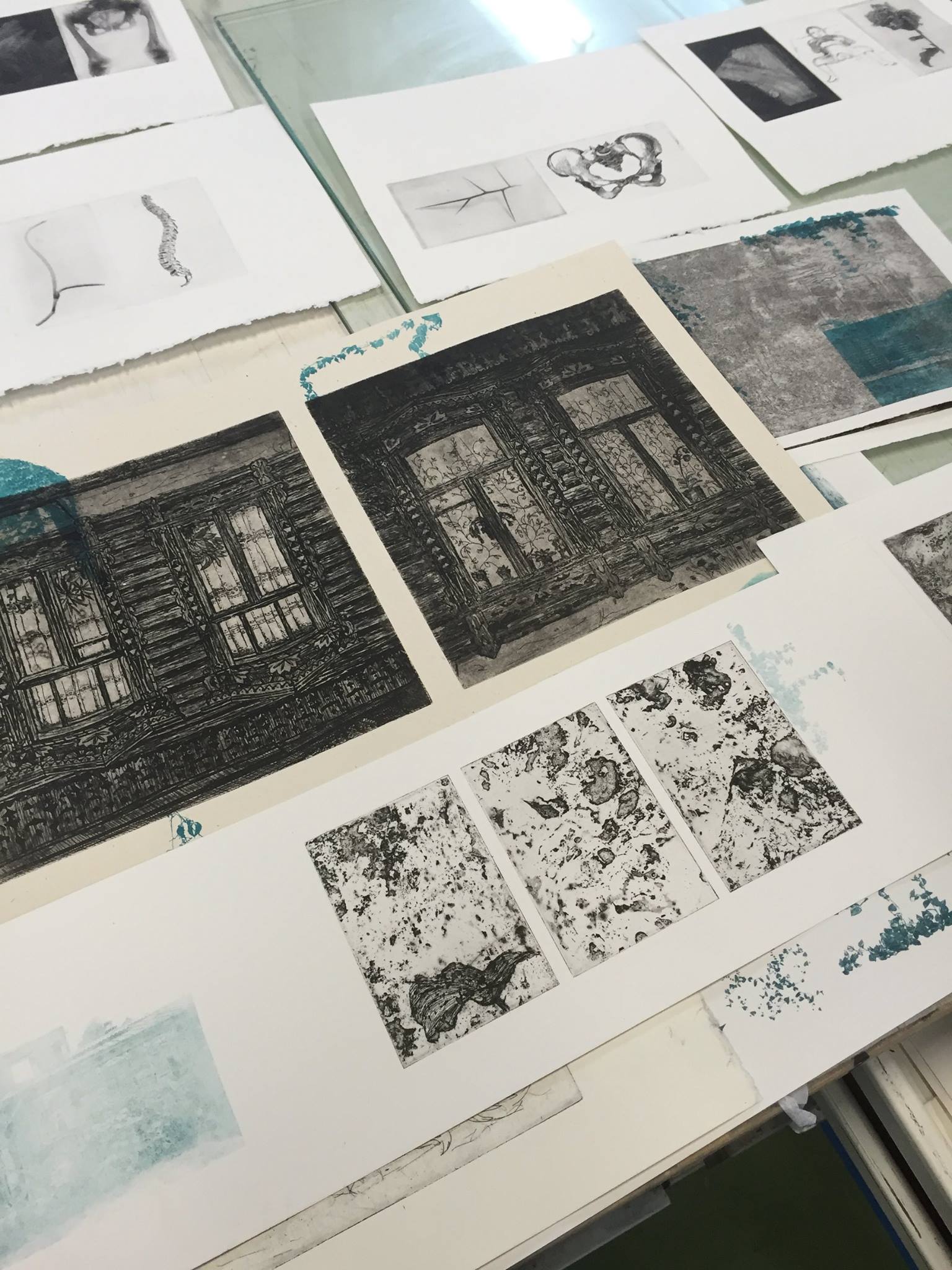
The project is realized with the kind support of Amsterdam Art Fund and Stichting Stokroos.
RELATED
Exhibition: SUPERIMPOSED ->
Motherland
is Calling!
is Calling!
2017 — 2018
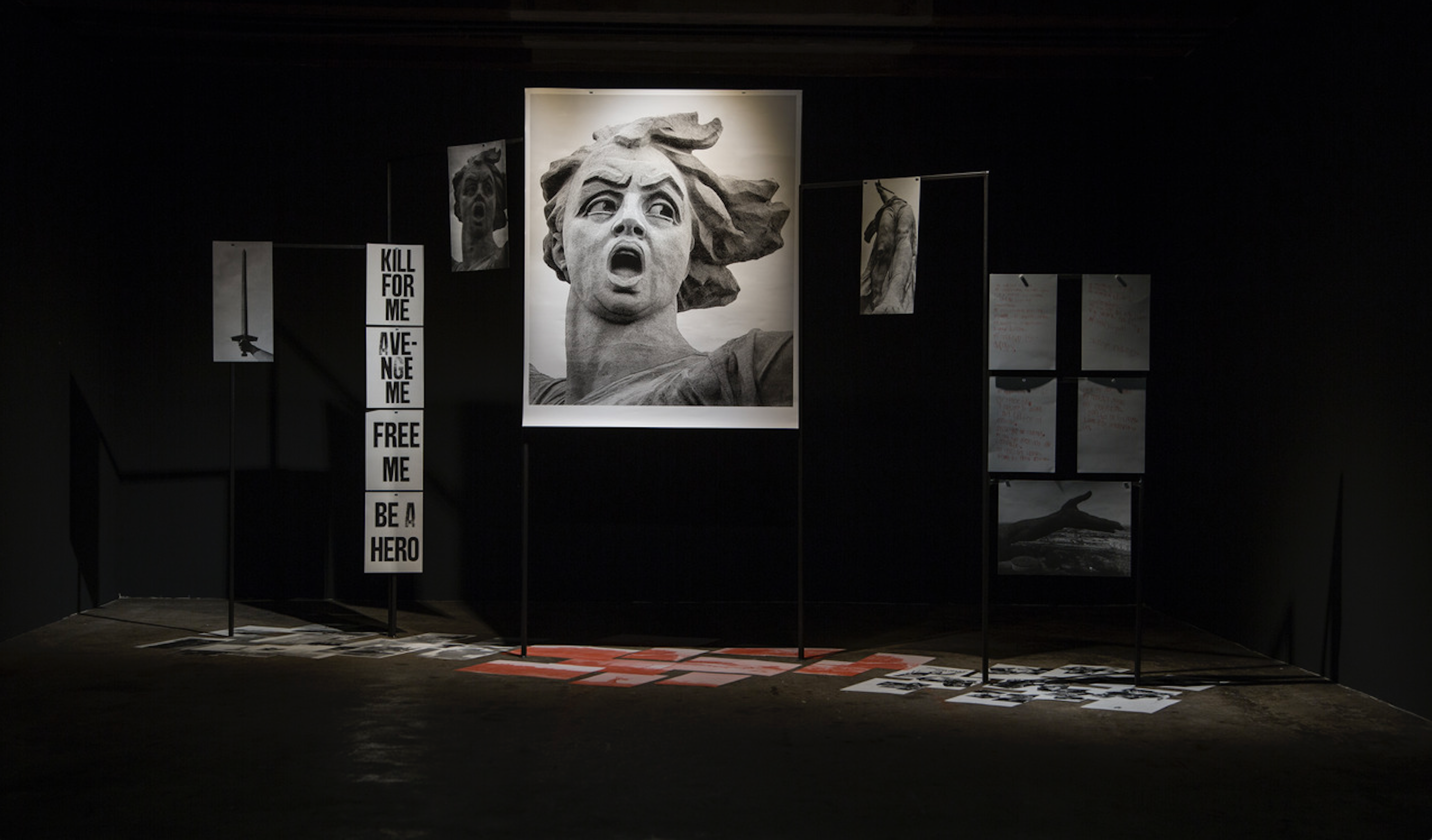
‘Motherland is calling’ is the name of an artistic research-based project I have been working on for the last two years. The title comes from the name of the statue in Volgograd city (formerly Stalingrad) in Russia. The ‘Motherland is calling’1 statue is a part of a monumental ensemble commemorating the Battle of Stalingrad that was built in 1967. ‘Motherland is calling’ is a gigantic woman – ‘motherland’ – with a mouth wide open, calling her ‘children’ to the war, holding her sword high up. The whole territory around the sculpture is a monumental ensemble and a burial place for about 45.000 Soviet soldiers.
The idea to research this topic comes from my personal biographical fascination. I was born in Volgograd and visited the monument several times. The place has a ‘saint horror’ atmosphere and is perceived as being ‘sacred’ in Russian ideology. The same way it is presented in many related texts, songs, and films. The feeling of this ‘saint horror’ [in front of the sculpture, in front of the motherland, in front of the mother (?), in front of any war-related objects, in front of the ‘war’] was cultivated from the childhood, and is forming a part of ‘soviet’ identity. It follows me through all my life, and I see similar feelings in many Russian-speaking people. I want to evaluate this ‘saint horror’ and to give it an artistic shape. At the moment the researched content consists of a collection of texts and images related to the history and ideology behind this ‘Motherland is calling’ monument.
CONCEPT
More than 70 years ago, WW-II was finished. But there are still places where you can feel the war's presence; it is kept there, captured in shapes. These places became a living memory for several generations since the end of the war. In Russia this memorization grew in a sort of ‘war cult’ comparable to religious cult (especially in the time when religion was obscured). In my research I focus on one particular monument – ‘Motherland is calling’. It became a symbolic sacred figure of the motherland, victory and memory.
The project ‘Motherland is calling’ takes this statue as a starting point for the artistic research on the role of female warrior figures in a war cult and propaganda.
Many countries with war history have statues of ‘motherlands‘ (or concepts of it). Some researchers see these ‘motherlands’ as symbolic war-goddesses. A female character represents ‘motherland’, that needs to be protected, or the one that is calling for protection, or just calling to fight. It is an emotional manipulation that triggers feelings of anger, pride, fear, honor and horror. War as the horrible act of humanity is substituted by the concept of a sacred act (“to die for the Motherland”).
I take this particular ‘Motherland is calling’ sculpture, as a study case of the phenomena of ‘motherland‘ sculptures in general. I study its multi-layered symbolism, its role in shaping the war perception and people’s personal ideologies (mine in particular).
Following concepts are relevant to the research: Motherland, Femininity, War, Cults-creating processes and a Monument, as a cult object. As a result of this research I would like to create a nonlinear narration in the form of a visual essay, presented in an installation setting, and a series of prints.
The project ‘Motherland is calling!’ researches eastern european ‘mother vs. motherland’ phenomenon based on the symbolism of the Mother-Motherland monument in Volgograd, Russia.
The project is realized with the kind support of Mondriaan Fund and Wilhelmina E.Jansen Fonds.
RELATED
Exhibition: Motherland is Calling! at Corridor Project space ->
Motherland is calling! project’s blog ->
The idea to research this topic comes from my personal biographical fascination. I was born in Volgograd and visited the monument several times. The place has a ‘saint horror’ atmosphere and is perceived as being ‘sacred’ in Russian ideology. The same way it is presented in many related texts, songs, and films. The feeling of this ‘saint horror’ [in front of the sculpture, in front of the motherland, in front of the mother (?), in front of any war-related objects, in front of the ‘war’] was cultivated from the childhood, and is forming a part of ‘soviet’ identity. It follows me through all my life, and I see similar feelings in many Russian-speaking people. I want to evaluate this ‘saint horror’ and to give it an artistic shape. At the moment the researched content consists of a collection of texts and images related to the history and ideology behind this ‘Motherland is calling’ monument.
CONCEPT
More than 70 years ago, WW-II was finished. But there are still places where you can feel the war's presence; it is kept there, captured in shapes. These places became a living memory for several generations since the end of the war. In Russia this memorization grew in a sort of ‘war cult’ comparable to religious cult (especially in the time when religion was obscured). In my research I focus on one particular monument – ‘Motherland is calling’. It became a symbolic sacred figure of the motherland, victory and memory.
The project ‘Motherland is calling’ takes this statue as a starting point for the artistic research on the role of female warrior figures in a war cult and propaganda.
Many countries with war history have statues of ‘motherlands‘ (or concepts of it). Some researchers see these ‘motherlands’ as symbolic war-goddesses. A female character represents ‘motherland’, that needs to be protected, or the one that is calling for protection, or just calling to fight. It is an emotional manipulation that triggers feelings of anger, pride, fear, honor and horror. War as the horrible act of humanity is substituted by the concept of a sacred act (“to die for the Motherland”).
I take this particular ‘Motherland is calling’ sculpture, as a study case of the phenomena of ‘motherland‘ sculptures in general. I study its multi-layered symbolism, its role in shaping the war perception and people’s personal ideologies (mine in particular).
Following concepts are relevant to the research: Motherland, Femininity, War, Cults-creating processes and a Monument, as a cult object. As a result of this research I would like to create a nonlinear narration in the form of a visual essay, presented in an installation setting, and a series of prints.
The project ‘Motherland is calling!’ researches eastern european ‘mother vs. motherland’ phenomenon based on the symbolism of the Mother-Motherland monument in Volgograd, Russia.
The project is realized with the kind support of Mondriaan Fund and Wilhelmina E.Jansen Fonds.
RELATED
Exhibition: Motherland is Calling! at Corridor Project space ->
Motherland is calling! project’s blog ->
INSIDEOUT
2015 — 2016
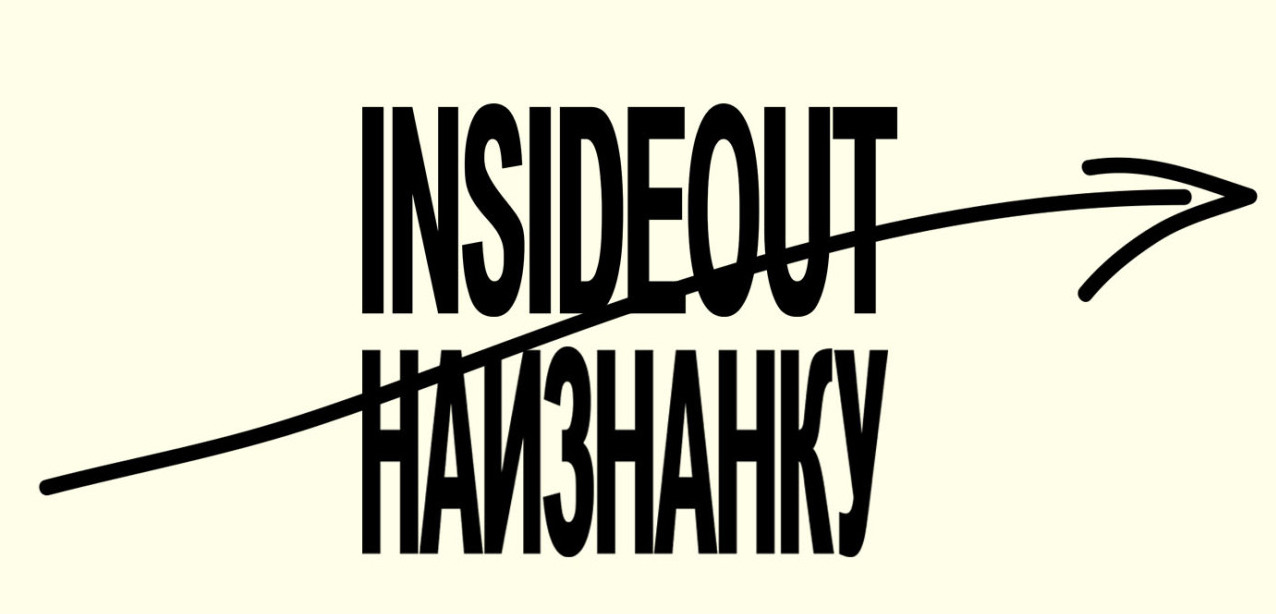
INSIDEOUT is a series of 8 tours that are focused on private observations and personal stories of Moscow’s citizens united under the theme of ‘the East’ and ‘the West.’ Every day from 23rd till the 30th of September a new protagonist welcomes us for in his apartment or other place selected by him.
In 1986 Jan Hoet created his iconic project Chambres d’amis, during which citizens of Ghent allowed their apartments entirely or partly to be transformed into pieces of art. Inspired by the idea of slipping out of borders of an exhibition format we would like to work with citizens of Moscow that will touch upon topics of urbanism, linguistics, politics, media, spirituality.
INSIDEOUT combines insider and outsider glimpse on Russia’s capital, proposes to explore a way of looking behind the curtain of mass media representations and clichés. It speaks back to Russia’s geopolitical contradictions and urges to open a discussion about its relation towards the East and the West. INSIDEOUT is an experiment that aims to open up a dialogue about possibilities of interaction with an everyday environment. Project’s main goal is to study personal stories and spaces as pieces of art in themselves. It involves anthropological, psychological, ethnological and sociological levels.
INSIDEOUT is a collaborative project of the No Land’s Men foundation (curator Katia Krupennikova, artists Olga Ganzha and masharu). Created and first presented during the 6th Moscow biennial of contemporary art.
![]()
![]()
![]()
First set in Moscow as a part of the special program of the 6th Moscow Biennale for contemporary art, INSIDEOUT presented 8 days of public meetings in apartments of Moscow citizens, not connected to contemporary art scene, but whose professional or personal interests embrace the relation between the ‘East’ and the ‘West’. For Russians, whose country’s territory is shared between Europe and Asia, and whose culture and direction politics has been swinging through its complex history, it is difficult culturally and historically to relate to either ‘East’ or’ ‘West’. Through the meetings the artists were trying to research this phenomena from various perspectives (politics, language, everyday life, music, geopolitics, culture, traditions).
![]()
![]()
![]() All the 8 days of the project were video-documented and edited into a film, that was premiered at the first day of symposium.
All the 8 days of the project were video-documented and edited into a film, that was premiered at the first day of symposium.
As the second step of the project the artists look at the researched topics from Dutch perspective. How is national identity formed and how the notions of ‘east’ and 'west’ affect it? How does colonial past/postcolonial history changes national identity? How is visual culture affected by politics of division?
At that stage of the project resulted in a symposium program, an exhibition and a series of screenings of the INSIDEOUT film in The Netherlands.
![]()
![]()
![]()
![]()
INSIDEOUT is made possible with support of AFK, Stichting Stokroos, Stiching Strand Links, Stichting Prins Bernhard Cultuurfonds, Wilhelmina E. Jansen Fonds, Royal Netherlands Embassy in Moscow and Moscow Biennale of Contemporary Art.
RELATED
INSIDEOUT / НАИЗНАНКУ ->
INSIDEOUT symposium ->
INSIDEOUT screenings ->
In 1986 Jan Hoet created his iconic project Chambres d’amis, during which citizens of Ghent allowed their apartments entirely or partly to be transformed into pieces of art. Inspired by the idea of slipping out of borders of an exhibition format we would like to work with citizens of Moscow that will touch upon topics of urbanism, linguistics, politics, media, spirituality.
INSIDEOUT combines insider and outsider glimpse on Russia’s capital, proposes to explore a way of looking behind the curtain of mass media representations and clichés. It speaks back to Russia’s geopolitical contradictions and urges to open a discussion about its relation towards the East and the West. INSIDEOUT is an experiment that aims to open up a dialogue about possibilities of interaction with an everyday environment. Project’s main goal is to study personal stories and spaces as pieces of art in themselves. It involves anthropological, psychological, ethnological and sociological levels.
INSIDEOUT is a collaborative project of the No Land’s Men foundation (curator Katia Krupennikova, artists Olga Ganzha and masharu). Created and first presented during the 6th Moscow biennial of contemporary art.



First set in Moscow as a part of the special program of the 6th Moscow Biennale for contemporary art, INSIDEOUT presented 8 days of public meetings in apartments of Moscow citizens, not connected to contemporary art scene, but whose professional or personal interests embrace the relation between the ‘East’ and the ‘West’. For Russians, whose country’s territory is shared between Europe and Asia, and whose culture and direction politics has been swinging through its complex history, it is difficult culturally and historically to relate to either ‘East’ or’ ‘West’. Through the meetings the artists were trying to research this phenomena from various perspectives (politics, language, everyday life, music, geopolitics, culture, traditions).

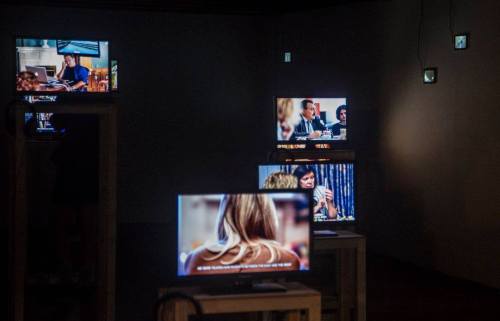

As the second step of the project the artists look at the researched topics from Dutch perspective. How is national identity formed and how the notions of ‘east’ and 'west’ affect it? How does colonial past/postcolonial history changes national identity? How is visual culture affected by politics of division?
At that stage of the project resulted in a symposium program, an exhibition and a series of screenings of the INSIDEOUT film in The Netherlands.

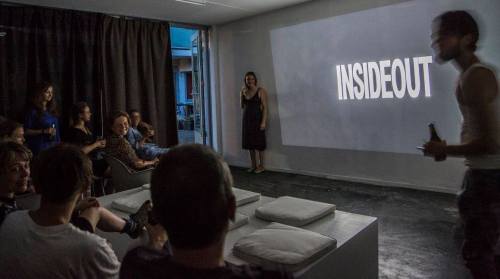


INSIDEOUT is made possible with support of AFK, Stichting Stokroos, Stiching Strand Links, Stichting Prins Bernhard Cultuurfonds, Wilhelmina E. Jansen Fonds, Royal Netherlands Embassy in Moscow and Moscow Biennale of Contemporary Art.
RELATED
INSIDEOUT / НАИЗНАНКУ ->
INSIDEOUT symposium ->
INSIDEOUT screenings ->
